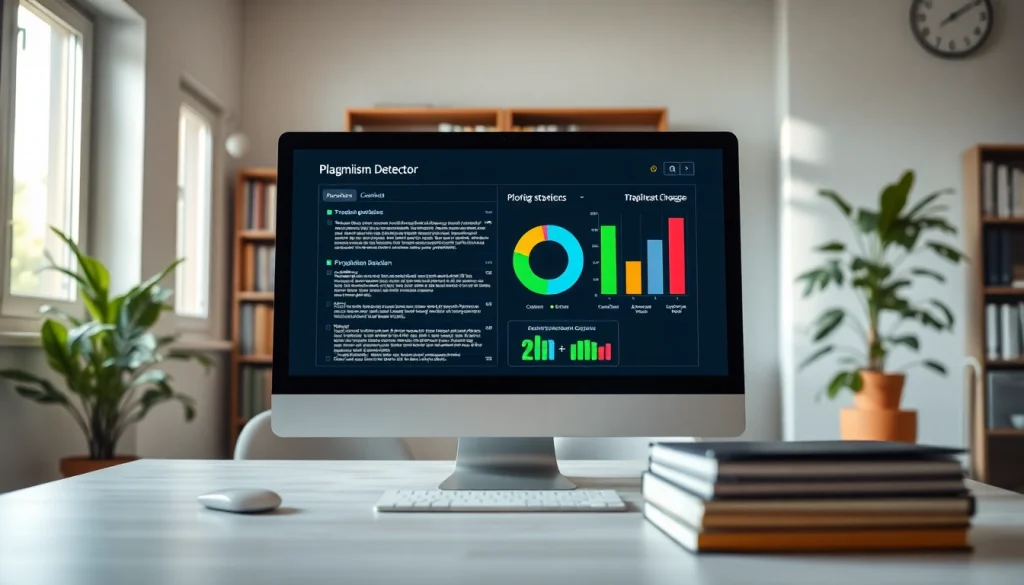Introduction to Plagiarism Detectors
In a world where written content is more accessible than ever, ensuring the originality of that content has become increasingly critical. Plagiarism is a serious offense that can lead to academic penalties and damage to professional reputations. One powerful tool that helps individuals and organizations maintain integrity in their writing is a plagiarism detector. These digital tools are designed to analyze text for similarities against vast databases of existing content, enabling users to identify potential instances of copied material and revise their work accordingly.
What is a Plagiarism Detector?
A plagiarism detector is a software or online tool that checks a piece of text against a database of published materials and web content. By doing so, it identifies sections of text that are identical or similar to other sources, providing the user with the percentage of originality. Most plagiarism detectors offer additional features such as citation recommendations, grammar checks, and style suggestions, making them valuable for students, educators, and professionals alike.
Importance of Plagiarism Detection
The importance of plagiarism detection cannot be overstated. In academic settings, plagiarism can lead to severe consequences, including loss of credibility, failing grades, or even expulsion. For professionals, plagiarism can tarnish reputations and lead to legal repercussions. Ultimately, plagiarism detection plays a crucial role in promoting original thought and creativity. Furthermore, it fosters trust between writers and readers, ensuring that content is authentic and valuable.
How Plagiarism Detectors Work
Plagiarism detectors utilize advanced algorithms and machine learning techniques to analyze text. Upon submission, the tool breaks down the text into smaller segments and compares these segments with an extensive database of web pages, books, articles, and academic papers. The tool identifies similarities, highlights matching text, and provides a report summarizing the findings along with a percentage indicating the level of originality. This process involves multiple methods, including:
- String Matching: Compares the text against existing content line-by-line.
- Semantic Analysis: Evaluates the meaning behind the text to identify paraphrased content.
- Citation Tracking: Checks for proper attribution and citation of sources.
The Benefits of Using a Plagiarism Detector
Enhancing Originality in Writing
Using a plagiarism detector is an effective way to boost the originality of writing. Writers can take advantage of these tools to ensure that their ideas are expressed uniquely and that they have not inadvertently copied another’s work. By making this a regular practice, writers deepen their understanding of the creative process, cultivate their voices, and contribute to the originality of relevant fields.
Meeting Academic Standards
In educational institutions, originality is paramount. Most colleges and universities have strict policies against plagiarism. By employing a plagiarism detector, students can ensure that their work adheres to academic standards. This practice helps them avoid potential disciplinary actions while reinforcing their commitment to quality and integrity in their scholarly pursuits.
Protecting Intellectual Property
For authors, researchers, and creators, protecting intellectual property is essential for maintaining the value of their work. Plagiarism detectors can safeguard against unauthorized use by identifying instances of copying. Moreover, many of these tools offer detailed reports that can prove invaluable in cases where intellectual property disputes arise.
Choosing the Right Plagiarism Detector
Key Features to Consider
When choosing a plagiarism detector, it’s essential to consider several key features:
- Database Size: A larger database offers a higher likelihood of successfully detecting plagiarism.
- Report Quality: Look for detectors that provide comprehensive reports, including highlighted sections and suggestions for improvement.
- User Interface: An intuitive interface will make the tool easier to navigate and use effectively.
- Cost: While some tools offer free versions, premium options often come with additional features and comprehensive services.
- Verification Process: The best tools will provide a detailed description of their detection process, ensuring transparency in how results are determined.
Comparing Popular Plagiarism Detectors
Not all plagiarism detectors are created equal. Here are reviews of some popular options:
- Grammarly: Known primarily as a grammar checker, Grammarly also offers a robust plagiarism detection feature. It scans text against billions of web pages to provide accurate results and integrates seamlessly with various writing platforms.
- Turnitin: Widely used in academic settings, Turnitin not only identifies potential plagiarism but also serves as a teaching tool that helps improve writing skills by providing feedback on citation practices.
- PapersOwl: This tool is tailored for students, offering free access with an AI-powered report feature that highlights duplicate content and suggests revisions.
- Duplichecker: A free plagiarism checker that offers basic functionalities suited for casual users, providing immediate feedback after text submission.
- Copyleaks: This tool is aimed at businesses and educational institutions, featuring advanced detection capabilities for various content types, including source code and AI-generated text.
User Reviews and Testimonials
User feedback is invaluable in determining which plagiarism detectors perform best. Reviews often highlight factors such as accuracy, ease of use, and customer support. For instance, many users of Grammarly praise its user-friendly interface and accurate checks, while Turnitin users appreciate the detailed feedback that helps students improve their writing. On the other hand, some users cite drawbacks such as costs associated with premium features or technical glitches with certain platforms. Evaluating user testimonials is a practical way to gauge the effectiveness and reliability of various plagiarism detectors.
Best Practices for Using a Plagiarism Detector
Running Pre-Submission Checks
Before submitting any writing, always run it through a plagiarism detector. This proactive step helps identify potential issues before they become problems. Ensure that you check version-controlled documents, as multiple drafts can lead to accidental plagiarism due to similar phrasing and ideas.
Interpreting the Results
Understanding the results provided by a plagiarism detector is crucial. If the report highlights matches, assess whether they are properly cited or if revisions are needed. Not all flagged content is necessarily plagiarized; quotations or common phrases may appear with high similarity. Therefore, practitioners should critically analyze flagged sections before jumping to conclusions.
Steps for Revision Based on Feedback
Once plagiarism has been identified, take immediate action to revise the text. This can involve rephrasing, summarizing, or paraphrasing the flagged sections. Remember to provide proper citations for any content derived from other sources. Engaging in this revision process not only enhances originality but also strengthens your understanding of the topic at hand.
Future Trends in Plagiarism Detection Technology
AI and Machine Learning Applications
The landscape of plagiarism detection is evolving with the integration of artificial intelligence (AI) and machine learning (ML). These technologies enable more sophisticated comparison algorithms that can understand context, semantics, and stylistic elements of writing. Future detectors may not just highlight identical phrases but also analyze the uniqueness of ideas and patterns across different pieces of text, resulting in more accurate and user-friendly reports.
Integration with Educational Tools
As educational tools become more advanced, plagiarism detectors are likely to be integrated into platforms like learning management systems (LMS) and writing software. This will provide users with real-time feedback as they write, making it easier to maintain academic integrity from the outset of the writing process. Features such as citation generation and grammar correction will further enhance the user experience, creating a seamless workflow for students and educators alike.
Challenges and Opportunities Ahead
Despite the advancements, challenges remain in the plagiarism detection landscape. Issues such as false positives, privacy concerns, and the need for adaptable algorithms that can keep up with the ever-evolving nature of content creation pose ongoing hurdles. Nevertheless, these challenges present opportunities for companies and developers to innovate further, creating bespoke solutions for institutions and businesses aiming to uphold originality and intellectual property rights.





